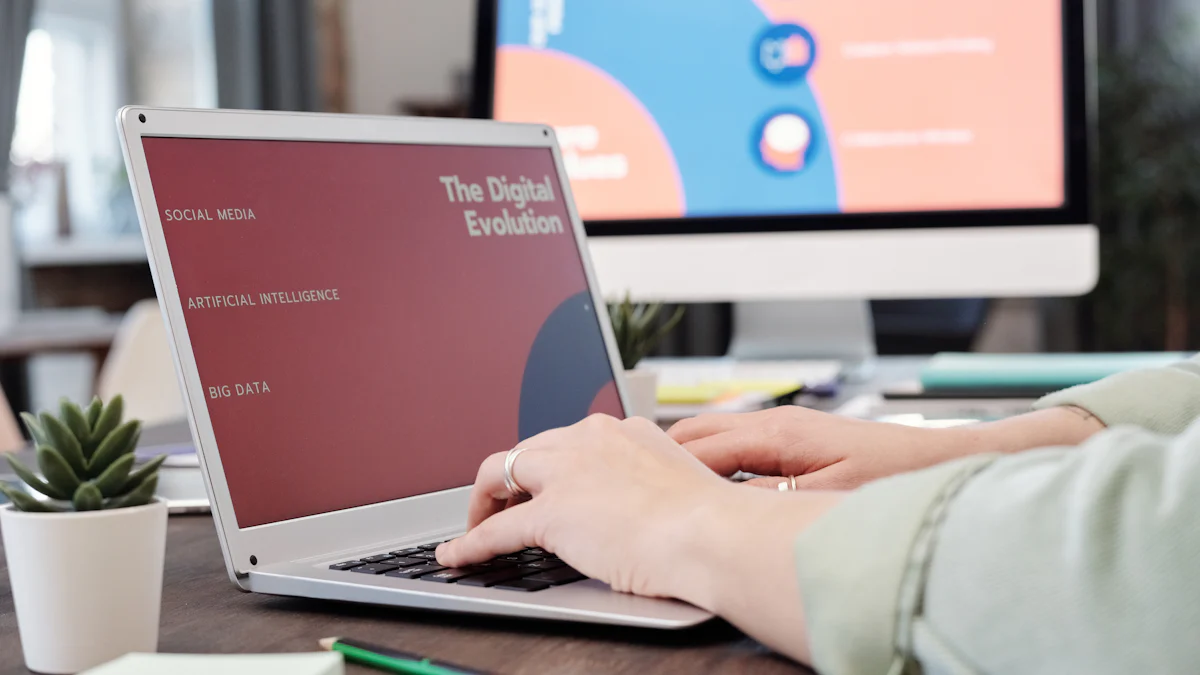Why Microsoft is at the Forefront of Hybrid Work Solutions

Hybrid work has become a pivotal model in today's business landscape. It allows employees to split their time between remote and in-office work, offering flexibility and enhancing productivity. A significant 60% of remote-enabled workers in the United States now prefer hybrid work options. This shift is not just a trend but a necessity for modern businesses. Microsoft plays a crucial role in advancing these solutions. With tools like Microsoft 365, you can empower your workforce to thrive in both remote and on-site environments, ensuring seamless collaboration and communication.
The Rise of Hybrid Work

Understanding Hybrid Work
Definition and Characteristics
Hybrid work combines the best of both worlds: remote and in-office work. You can enjoy the flexibility of working from home while still having the option to collaborate in person. This model adapts to your needs, offering a balance between professional and personal life. It provides you with the opportunity to choose where you work best, enhancing your productivity and satisfaction.
Evolution of Work Models
Work models have evolved significantly over the years. Traditional office work dominated the past, requiring you to be physically present at your workplace. Remote work emerged as a necessity during global disruptions, allowing you to work from anywhere. Now, the hybrid model has taken center stage, offering a flexible approach that combines the advantages of both remote and office work. This evolution reflects the changing needs of the modern workforce, emphasizing adaptability and efficiency.
Benefits of Hybrid Work
Business Continuity
Hybrid work ensures business continuity by allowing you to work seamlessly, regardless of location. In times of unexpected disruptions, such as natural disasters or pandemics, you can maintain productivity without compromising safety. This model supports uninterrupted operations, keeping your business resilient and agile.
Flexibility and Work-Life Balance
Flexibility is a hallmark of hybrid work. You can tailor your schedule to fit personal commitments, reducing stress and enhancing work-life balance. This flexibility leads to higher job satisfaction, as you can manage your time effectively. By choosing when and where to work, you can achieve a harmonious blend of professional and personal responsibilities.
Increased Productivity and Employee Satisfaction
Hybrid work boosts productivity by allowing you to work in environments where you feel most comfortable and focused. You can avoid the distractions of a traditional office setting, leading to more efficient work. Additionally, this model fosters employee satisfaction by providing autonomy and control over your work environment. As a result, you feel more engaged and motivated, contributing to a positive workplace culture.
Microsoft's Role in Hybrid Work
Microsoft stands at the forefront of hybrid work solutions, offering innovative technologies and strategic partnerships that empower you to work efficiently, whether you're at home or in the office.
Innovative Technologies
Microsoft Teams and Collaboration Tools
Microsoft Teams serves as a cornerstone for collaboration in a hybrid work environment. You can engage in online meetings, chat sessions, and shared workspaces, all designed to enhance productivity. These tools allow you to communicate seamlessly with your colleagues, regardless of your location. With features like cloud-based file storage and shared tasks, Microsoft Teams ensures that you stay connected and productive.
Cloud Solutions and Security
Microsoft's cloud solutions, such as Azure, provide a secure and flexible platform for hybrid work. You can access your work from anywhere, knowing that your data is protected. Microsoft Intune helps manage devices and applications, ensuring that your work environment remains secure. This focus on security allows you to work confidently, knowing that your information is safe.
Strategic Partnerships and Integrations
Collaborations with Other Tech Giants
Microsoft collaborates with other tech giants to enhance its hybrid work solutions. These partnerships bring together the best technologies, providing you with a comprehensive suite of tools. By working with industry leaders, Microsoft ensures that you have access to cutting-edge solutions that meet your hybrid work needs.
Integration with Third-Party Applications
Microsoft's integration with third-party applications offers you flexibility and choice. You can customize your work environment to suit your preferences, integrating tools that enhance your productivity. This adaptability allows you to create a personalized workspace that supports your unique workflow.
Future Potential and Growth of Hybrid Work
Technological Advancements
AI and Machine Learning in Hybrid Work
Artificial Intelligence (AI) and Machine Learning (ML) are transforming hybrid work environments. You can leverage AI to bridge the gap between on-site and remote workers, ensuring seamless collaboration. AI helps manage workload and reduces the feeling of overload, a common challenge in hybrid settings. By integrating AI, you can enhance productivity and streamline operations. Studies show that AI plays a crucial role in preparing organizations for the future of work, making it an indispensable tool in hybrid models.
Virtual Reality and Augmented Reality
Virtual Reality (VR) and Augmented Reality (AR) are revolutionizing how you experience hybrid work. These technologies create immersive environments that enhance remote collaboration. You can participate in virtual meetings that feel as real as in-person interactions. VR and AR provide innovative solutions for training and development, allowing you to engage in interactive learning experiences. As these technologies evolve, they will play a significant role in shaping the future of hybrid work, offering new ways to connect and collaborate.
Improved Work Culture
Inclusivity and Diversity
Hybrid work models promote inclusivity and diversity by allowing you to work from locations that suit your needs. This flexibility attracts a diverse workforce, bringing varied perspectives and ideas to the table. You can create a more inclusive work environment by embracing hybrid work, which supports employees with different backgrounds and lifestyles. Companies benefit from this diversity, as it fosters innovation and creativity, driving business success.
Employee Well-being and Support
Your well-being is a priority in hybrid work environments. Companies recognize the importance of supporting employees through flexible work arrangements. You can enjoy a better work-life balance, reducing stress and improving job satisfaction. Organizations offer resources and programs to support your mental health and well-being. By prioritizing employee support, companies create a positive work culture that enhances productivity and engagement. Hybrid work models empower you to thrive, both personally and professionally.
Different Models of Hybrid Work

Flexible Work Schedules
Remote-First Approach
In a remote-first approach, you prioritize working from home. This model allows you to enjoy the comfort and convenience of your home environment while maintaining productivity. Many companies, like Google, have embraced this strategy to empower employees. You can focus on tasks without the distractions of a traditional office setting. This approach also reduces commuting time, giving you more time for personal activities. Surveys by Gallup and Future Forum reveal that employees prefer hybrid work models, with remote-first being a popular choice.
Office-First Approach
The office-first approach emphasizes in-office work while still offering remote options. You benefit from face-to-face interactions and immediate access to resources. This model suits those who thrive in a structured environment. It fosters collaboration and team spirit, which can enhance creativity and innovation. By spending more time in the office, you can build stronger relationships with colleagues. This approach provides a balance between remote flexibility and the advantages of in-person work.
Hybrid Work Policies
Customizable Work Arrangements
Customizable work arrangements allow you to tailor your schedule to fit your needs. You can choose when and where to work, creating a personalized work environment. This flexibility supports work-life balance, reducing stress and increasing job satisfaction. Companies recognize the value of hybrid work for attracting and retaining top talent. By offering customizable options, they cater to diverse employee preferences, enhancing overall productivity.
Performance Metrics and Evaluation
In hybrid work models, performance metrics and evaluation play a crucial role. You focus on outcomes rather than hours spent at a desk. This approach encourages you to set clear goals and measure success based on results. It fosters accountability and transparency, ensuring that you remain productive and engaged. By evaluating performance through metrics, companies can support your growth and development. This method aligns with the evolving needs of the modern workforce, emphasizing efficiency and effectiveness.
Aligning with Employee Expectations
Understanding Employee Needs
Surveys and Feedback Mechanisms
To align with employee expectations, you must first understand their needs. Conducting surveys and gathering feedback are essential steps in this process. Survey Results: A significant 88% of government employees express satisfaction with their remote work arrangements. This data highlights the importance of listening to employee preferences. By regularly collecting feedback, you can identify areas for improvement and make informed decisions that enhance the work experience.
Personalization of Work Experience
Personalizing the work experience is crucial for meeting employee expectations. You can tailor work environments and schedules to fit individual preferences. This approach not only boosts job satisfaction but also increases productivity. When employees feel valued and understood, they are more likely to engage fully in their roles. Offering personalized options demonstrates a commitment to employee well-being and fosters a positive workplace culture.
Building a Supportive Work Environment
Training and Development Programs
A supportive work environment includes opportunities for growth and development. Implementing training programs helps you acquire new skills and advance in your career. These programs should address both technical and soft skills, ensuring a well-rounded development. By investing in employee growth, companies show their dedication to your professional success. This commitment enhances job satisfaction and retention.
Mental Health and Wellness Initiatives
Mental health and wellness initiatives are vital components of a supportive work environment. Providing resources and support for mental well-being helps you manage stress and maintain a healthy work-life balance. Companies can offer workshops, counseling services, and wellness programs to support your mental health. Prioritizing these initiatives creates a culture of care and respect, where you feel valued and supported. This focus on well-being contributes to a more engaged and productive workforce.
Leveraging Hybrid Work for Competitiveness
Attracting and Retaining Talent
Hybrid work has become a powerful tool for attracting and retaining top talent. You can offer competitive compensation and benefits to make your organization more appealing. Employees value flexibility, and hybrid work provides that. According to an IWG survey, hybrid work is not just a job benefit; it is crucial for recruitment and retention.
Competitive Compensation and Benefits
Offering competitive compensation and benefits is essential. You can attract skilled professionals by providing packages that include flexible work options. This approach not only draws talent but also keeps them engaged and satisfied. Studies show that employee turnover decreases by 35% with hybrid work, without affecting performance or career growth.
Career Growth Opportunities
Career growth opportunities are vital for retaining talent. You can create pathways for advancement within your organization. Hybrid work allows you to offer diverse roles and responsibilities, catering to different career aspirations. Employees appreciate the chance to grow and develop, which enhances their loyalty and commitment to your company.
Driving Business Momentum
Hybrid work drives business momentum by fostering innovation and creativity. You can expand your market reach and achieve global success through this model. The flexibility of hybrid work encourages new ideas and solutions, propelling your business forward.
Innovation and Creativity
Innovation thrives in a hybrid work environment. You can encourage creativity by allowing employees to work in settings that inspire them. This freedom leads to fresh perspectives and innovative solutions. Companies like Apple and Meta have embraced hybrid work to boost creativity and drive success.
Market Expansion and Global Reach
Hybrid work enables market expansion and global reach. You can tap into new markets by leveraging remote work capabilities. This model allows you to connect with clients and partners worldwide, enhancing your business's global presence. By adopting hybrid work, you position your company for growth and competitiveness in the international arena.
Challenges and Considerations
Managing Remote Teams
Managing remote teams presents unique challenges. You may encounter difficulties in communication and collaboration. Communication and Collaboration Challenges often arise because remote work limits face-to-face interactions. According to reports, 45.8% of remote managers cite lack of communication as their biggest hassle. This can lead to slower work progress and longer times to train new hires. You might also notice an increased risk of burnout among team members due to feelings of isolation.
To overcome these challenges, you should implement effective communication tools and strategies. Encourage regular check-ins and use platforms like Microsoft Teams to facilitate seamless communication. By doing so, you can ensure that your team remains connected and productive.
Monitoring and Accountability
Monitoring and accountability are crucial in remote work settings. Without direct supervision, you might find it challenging to track your team's progress. It's important to establish clear expectations and performance metrics. This helps you maintain accountability and ensures that everyone stays on track.
You can use project management tools to monitor tasks and deadlines. These tools provide visibility into your team's activities, allowing you to address any issues promptly. By fostering a culture of accountability, you can enhance productivity and maintain high standards of work.
Security and Privacy Concerns
Security and privacy concerns are paramount in hybrid work environments. You must protect sensitive data and ensure compliance with regulations. Data Protection Measures are essential to safeguard your information. Implementing robust security protocols, such as encryption and multi-factor authentication, can help you achieve this.
Regularly update your software and conduct security audits to identify vulnerabilities. Educate your team about best practices for data protection. By prioritizing security, you can minimize risks and protect your organization's assets.
Compliance with regulations is another critical consideration. You need to stay informed about relevant laws and standards. This includes data protection regulations like GDPR or CCPA. Ensure that your practices align with these requirements to avoid legal issues. Compliance with regulations
Compliance with regulations is another critical consideration. You need to stay informed about relevant laws and standards. This includes data protection regulations like GDPR or CCPA. Ensure that your practices align with these requirements to avoid legal issues.
Develop a compliance strategy and conduct regular reviews to assess your adherence to regulations. By doing so, you can maintain trust with your clients and stakeholders. Prioritizing compliance not only protects your organization but also enhances your reputation in the industry.
Microsoft leads the way in hybrid work solutions, offering tools like Microsoft 365 that empower you to work flexibly. This approach enhances productivity and employee satisfaction. Hybrid work provides benefits such as reduced turnover and improved experiences. By adopting these models, you can align with modern workforce needs and remain competitive. Embrace hybrid work to ensure sustained success and innovation in your organization.
See Also
The High Demand for Microsoft 365 Experts
The Crucial Role of Microsoft Experts in Digital Transformation
Microsoft Viva's Impact on Employee Experience
The Importance of Having a Microsoft Expert in Every Business
The Benefits of Collaborating with a Microsoft-Focused Headhunter
